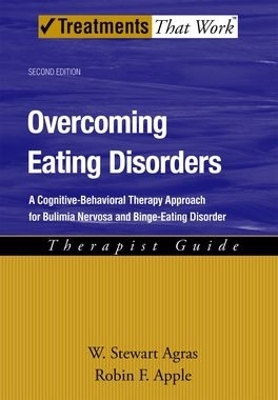
Overcoming Eating Disorders
A Cognitive-Behavioral Therapy Approach for Bulimia Nervosa and Binge-Eating Disorder, Therapist Guide
Seiten
2007
|
2nd Revised edition
Oxford University Press Inc (Verlag)
978-0-19-531169-3 (ISBN)
Oxford University Press Inc (Verlag)
978-0-19-531169-3 (ISBN)
This newly revised and updated Therapist Guide provides step-by-step instructions for treating Bulimia Nervosa and Binge-Eating Disorder. Based on the principles of Cognitive-Behavioral Therapy (CBT), the program described has proven highly effective in research studies and clinical trials.
The Overcoming Eating Disorders, Second Edition program addresses the cognitive-behavioral treatment of Bulimia Nervosa and Binge Eating Disorder. CBT has been proven the most effective treatment for helping patients improve their eating habits and overcome their disorder.
The treatment described is divided into three overlapping phases: behavior change, identifying binge triggers, and relapse prevention. The main focus of the program is the normalization of eating. Patients use self-monitoring forms to track their eating habits on a daily basis while they work toward establishing a pattern of 3 meals and 2 snacks per day eaten at regular intervals. Once a regular pattern of eating has been established, patients move on to recognizing and eliminating their triggers for binging and purging. CBT techniques like problem-solving and cognitive restructuring help patients deal with negative mood states, faulty interpersonal interactions, and errors in thinking. The final phase of treatment consists of a review of the positive changes that have occurred during treatment, as well as a discussion of any residual problems and ways to handle setbacks or lapses. Homework exercises are assigned at each session and play an important role in keeping patients motivated throughout the duration of treatment.
This newly revised and updated Therapist Guide includes expanded information regarding weight and shape concerns and an entirely new chapter on adapting the treatment for use as a time-limited, therapist-assisted self-help program. Complete with step-by-step instructions for delivering the treatment, this guide is an indispensable resource that no clinician can do without.
The Overcoming Eating Disorders, Second Edition program addresses the cognitive-behavioral treatment of Bulimia Nervosa and Binge Eating Disorder. CBT has been proven the most effective treatment for helping patients improve their eating habits and overcome their disorder.
The treatment described is divided into three overlapping phases: behavior change, identifying binge triggers, and relapse prevention. The main focus of the program is the normalization of eating. Patients use self-monitoring forms to track their eating habits on a daily basis while they work toward establishing a pattern of 3 meals and 2 snacks per day eaten at regular intervals. Once a regular pattern of eating has been established, patients move on to recognizing and eliminating their triggers for binging and purging. CBT techniques like problem-solving and cognitive restructuring help patients deal with negative mood states, faulty interpersonal interactions, and errors in thinking. The final phase of treatment consists of a review of the positive changes that have occurred during treatment, as well as a discussion of any residual problems and ways to handle setbacks or lapses. Homework exercises are assigned at each session and play an important role in keeping patients motivated throughout the duration of treatment.
This newly revised and updated Therapist Guide includes expanded information regarding weight and shape concerns and an entirely new chapter on adapting the treatment for use as a time-limited, therapist-assisted self-help program. Complete with step-by-step instructions for delivering the treatment, this guide is an indispensable resource that no clinician can do without.
W. Stewart Agras is Professor Emeritus of Psychiatry and Behavioral Sciences at Stanford School of Medicine. Robin F. Apple is Clinical Associate Professor of Psychiatry and Behavioral Sciences at Stanford School of Medicine.
TREATMENT PHASE 1 - BEHAVIOR CHANGE; TREATMENT PHASE 2 - IDENTIFYING BINGE TRIGGERS; TREATMENT PHASE 3 - MAINTAINING CHANGE; GUIDED SELF-HELP
| Erscheint lt. Verlag | 20.9.2007 |
|---|---|
| Reihe/Serie | Treatments That Work |
| Zusatzinfo | 13 black and white illustrations |
| Verlagsort | New York |
| Sprache | englisch |
| Maße | 253 x 180 mm |
| Gewicht | 268 g |
| Themenwelt | Medizin / Pharmazie ► Medizinische Fachgebiete ► Psychosomatik |
| Medizin / Pharmazie ► Medizinische Fachgebiete ► Psychiatrie / Psychotherapie | |
| ISBN-10 | 0-19-531169-8 / 0195311698 |
| ISBN-13 | 978-0-19-531169-3 / 9780195311693 |
| Zustand | Neuware |
| Haben Sie eine Frage zum Produkt? |
Mehr entdecken
aus dem Bereich
aus dem Bereich
Buch | Softcover (2023)
Urban & Fischer in Elsevier (Verlag)
CHF 65,80
Wie gründe und führe ich eine psychologische Praxis?
Buch | Softcover (2022)
Springer (Verlag)
CHF 53,15


